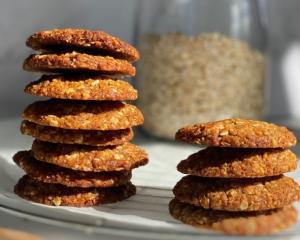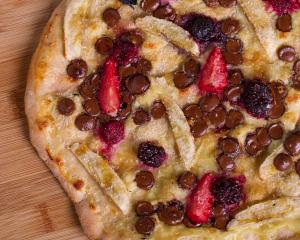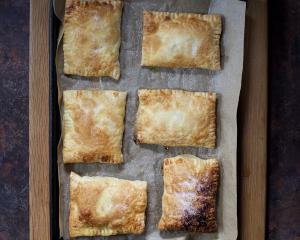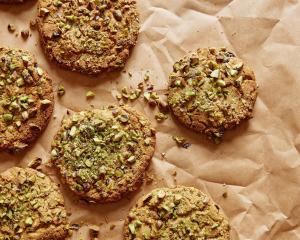
Chantarasak was born in Liverpool to a Thai father and an English mother and grew up mostly in Wales with many trips to visit family in Thailand.
"To this day, my favourite memories are of my grandmother’s food. She was a wonderful cook and the flavours weren’t solely Thai, but also nodded to our family’s distant roots in China."
In 2013 he left his London office job and relocated to Bangkok via a road-trip around the United States. It was on this journey he decided his future may be in food and he enrolled in culinary school in Bangkok — studying classical French cookery.
"I was hooked — and not only that I also discovered I was quite good at this cooking business."
He started working in professional kitchens on weekends and evenings first in French and European restaurants and then in as his interest in Thai food grew, he felt compelled to cook of his father’s heritage.
An opportunity to intern at world-renown restaurant Nahm under chefs David Thompson and Prin Pulsak came his way. It was rated as the number one restaurant in Asia and rated in the world top 50 rankings.

But soon home called and Chantarasak, feeling burnt out by the travelling and work, headed back to his childhood home in Wales. He then got work in Bristol where he was introduced to contemporary British cooking.
"After a little time I found myself longing for the flavours of Thailand."
He joined another chef doing old-style Thai food cooked with a blend of Asian and British ingredients in his London restaurant. During this time he became more curious about the relationship British ingredients could have with Thai cuisine.
"I soon realised that some of the indigenous foods found within the British Isles mirrored the flavour profiles of those found in Asia."
Chantarasak believes that Thai food is not solely defined by its ingredients but requires the considerable balancing act of the complex flavours synonymous with the cuisine — salty, sweet, spicy and sour.
"These flavours can all be found in the natural British larder."
He now seeks to preserve traditional Thai recipes by reimagining them using the finest ingredients from the best local farmers, while respecting his domestic British surroundings.
"It is not always easy to achieve but it has become a deeply rooted passion that I feel in my core when cooking."
That has translated in his book Kin Thai, which he hopes gives people the confidence to try cooking new recipes with unconventional ingredients and flavours. To help with this he has included information on Thai food, ingredients and equipment before recipes divided into chapters for salads, relishes, braises, stir fried, curries, snacks and sweets.
"Thai food doesn’t have to be made solely with Thai ingredients."
THE BOOK
This is an edited extract from Kin Thai by John Chantarasak, published by Hardie Grant London, RRP $49.99

Thai grilled chicken is an absolute delight and, in my opinion, is far superior to other grilled chicken dishes from around the world. The dish hails from Isaan, where barbecuing (grilling) over fire is a main cooking method.
Serves 4
1 tsp white peppercorns
1 tsp salt
2 Tbsp chopped coriander root or coriander stem
3 Tbsp chopped garlic
1 Tbsp palm or brown sugar
½ teaspoon ground turmeric
½ tsp ground coriander
3 Tbsp fish sauce
1 Tbsp vegetable oil
1 small chicken or poussin, about 450g
2 Tbsp sweet fish sauce
Method
Pound the white peppercorns and salt in a pestle and mortar to a fine powder, then add the coriander root and garlic and pound to a smooth paste. Add the sugar, turmeric, ground coriander, fish sauce and oil, and mix until combined and smooth.
Using a pair of heavy-duty scissors, cut the chicken along the backbone to butterfly (spatchcock) the bird. Place the chicken, breast-side up, on a cutting board. Gently, but with some authority, press down on the chicken using the palm of your hand so that the chicken becomes flattened. This will allow it to cook evenly on your charcoal barbecue (grill).
Rub the marinade all over the chicken, coating it thoroughly, then leave to marinate in the refrigerator for at least 6 hours or overnight.
When ready to cook, prepare a charcoal grill (barbecue), then cook the chicken over a medium heat for 15-20 minutes until cooked through. To do this, start by placing the exposed cavity side of the chicken on the grill and leave for two-thirds of the cooking time; the bones will protect the delicate white flesh from overcooking and becoming dry. Flip the chicken over so that it’s breast-side down, and cook for the final one-third of the cooking time to colour the skin a golden brown. Leave the chicken to rest in a warm spot for 5 minutes.
Before serving, use a pastry brush to liberally glaze the chicken with the sweet fish sauce. Transfer to a cutting board and carve into pieces. I would suggest halving the chicken down the middle of the breastbone and removing the legs, then separating the legs and thighs through the joint. Remove the smaller drumsticks and wings, then cut the breast through the bone into two to three pieces.
Sweet fish sauce
(nahm pla waan)
250g palm or brown sugar
¼ tsp shrimp paste
2.5cm piece of cassia bark, toasted
2 dried bird’s eye chillies, toasted
1 Tbsp fried shallots (hom jiaw)
2 Tbsp water
3 Tbsp fish sauce
1 star anise, toasted
1 Tbsp dried shrimp
1 Tbsp Fried Garlic
Method
Heat the palm sugar and water together in a large saucepan over a low heat until the sugar has completely dissolved. Add the shrimp paste, fish sauce, cassia bark, star anise and dried chillies, then bring to a simmer and cook for 5 minutes, or until slightly reduced. Test the consistency by spreading a small amount on a plate and chilling it in the refrigerator for a few minutes. The desirable consistency should be tacky and sticky but not too firm. Simmer for longer, or add water as necessary to achieve the right consistency.
 Koi pla Isaan - citrus-cured tuna
Koi pla Isaan - citrus-cured tuna

Koi involves lightly curing and cooking with the use of citrus, usually lime juice, and is not dissimilar to the ceviche found throughout South America. Traditionally, the protein is chopped and incorporated with a sour and spicy dressing, and eaten alongside sticky rice and plenty of fresh herbs. I’ve opted to use tuna, but salmon or trout would work equally well — just try to source the best-quality and freshest fish you can.
Serves 2
2 Tbsp fish sauce
3 Tbsp lime juice
1 Tbsp caster (superfine) sugar
1 teaspoon toasted chilli powder (prik bon) (below)
120g tuna loin or belly, diced into 2cm pieces
3 lemongrass stalks, root and outer husks removed, thinly sliced
½ small red onion, thinly sliced with the grain of the onion
1 spring onion (scallion), thinly sliced
3 Tbsp roughly chopped coriander (cilantro) sprigs
2 Tbsp mint leaves
1 Tbsp toasted rice powder (below)
To garnish
2 dried bird’s eye chillies, stems on, dry-toasted
2 Tbsp salmon or trout roe (optional)
Method
In a bowl, mix together the fish sauce, lime juice, sugar and toasted chilli powder, making sure the sugar is completely dissolved.
The mixture will taste hot, sour and salty.
In a large bowl, combine the diced tuna, lemongrass, red onion, spring onion, coriander and mint.
Toss with the dressing and plate immediately, as the tuna will start to cook as it combines with the acidic lime juice.
Sprinkle the rice powder over the top and garnish with the toasted dried bird’s eye chillies and salmon or trout roe, if using.
Toasted chilli powder - prik bon
This condiment and seasoning powder is beloved throughout Thailand for flavouring salad dressings, dipping sauces, soups, stir-fries and curries. Thai’s love for prik bon is so ingrained in their eating culture that this ubiquitous toasted chilli powder is found on all dining tables, from homes to street-food vendors and restaurants. Shop-bought crushed dried chilli flakes or chilli powder are fine to use, but you won’t get the same depth of flavour as you do when you dry-toast the chillies yourself until blistered, smoky and charred.
Makes 200g
200 g dried long red chillies, seeded
25 g dried bird’s eye chillies
Method
Dry-toast the dried long red chillies in a wok over a medium heat for 10 minutes, moving them around frequently so that the chillies colour evenly and darken. Some black blistering and charring is good for flavour, but too much will cause the final chilli
powder to become dark and bitter. Remove from the wok and repeat the process for the bird’s eye chillies, this time cooking for 5 minutes.
Blitz the chillies in a hand-held blender or spice grinder to a powder of your chosen texture. I prefer my prik bon with a little more texture than shop-bought chilli powder, more like that of sand. Be careful not to blitz any of the chilli seeds that have fallen
out of the chillies and become burnt and blackened while toasting, as these will be bitter. Store in an airtight container away from direct sunlight for up to two months.
Toasted rice powder — khao khua
This is a store cupboard ingredient that’s widely used in dishes throughout Isaan. The process showcases the resourcefulness of Thai cooks by essentially creating another ingredient from the rice grown in the poorer, rural areas of the country. Raw rice grains are dry-toasted over a low heat, giving a nutty and roasted flavour. Once ground into a powder, this provides texture, crunch and a subtle smoky flavour to dishes. Traditionally, this is done using sticky rice, which is grown abundantly in Isaan, but I have tested the process with jasmine rice, wild rice and even British grains such as pearl barley with great success.
Makes 100g
100g (cup) uncooked sticky rice
4 outer husks of lemongrass, chopped (optional)
2 makrut lime leaves (fresh or frozen) optional
Method
Dry-toast the uncooked rice with the lemongrass husks and makrut lime leaves in a wok or heavy-based pan over a low heat for 5 minutes, moving the rice constantly so that the grains turn a deep golden-brown colour and smell toasty and nutty.
Remove and discard the lemongrass and makrut lime leaves, then grind the toasted rice in a granite pestle and mortar to a somewhat coarse powder. Work in batches if necessary so as to not overcrowd the mortar. Alternatively, use a spice grinder or hand-held blender, but be careful not to overgrind the grains into too fine a powder. You are looking for a texture that resembles sand. Keep in an airtight container in a dark place for up to two weeks; any longer and the rice will lose its aromatic fragrance.
 Tort man pla - fish cakes with cucumber pickle
Tort man pla - fish cakes with cucumber pickle

Thai fish cakes are famous around the world — and rightfully so, as their intriguingly bouncy texture and delicious flavour, with red curry paste running through the fish mixture, make them a delight to eat at any time of the day. I like to serve them as a snack or precursor to a meal with traditional sweet pickled cucumber, shallots and chillies known as ajut in Thailand. Fish cakes also make a wonderful light lunch served with a few coils of kanom jim rice vermicelli noodles and sprigs of Thai basil. If you don’t have time to make the red curry paste, then use a good-quality shop-bought curry paste instead.
Serves 6
2 Tbsp salt
2 Tbsp caster (superfine) sugar
300 g white fish, filleted with pin bones and skin removed (cod, hake and monkfish all work well)
1 tsp palm sugar
2 Tbsp fish sauce
1 large egg, beaten
3 Tbsp finely sliced fine green beans
1 Tbsp finely sliced fingerroot (optional)
8 makrut lime leaves (fresh or frozen), finely shredded
4 Tbsp large Thai basil leaves
vegetable oil, for deep-frying
dried vermicelli noodles, cooked according to packet instructions and cooled to room temperature
Thai basil or coriander (cilantro) sprigs
Method
In a small bowl, mix together the salt and sugar. This is your cure mix. Sprinkle it over the fish and leave for 1 hour in the refrigerator to draw the moisture from the fish. Wipe the cure mix from the fish and wash under cold running water, then pat dry with paper towels.
Traditionally, Thai fish cakes are made using a pestle and mortar, but for the modern cook, a food processor saves time. Cut the fish into bite-size pieces and add to the food processor, along with 4 Tbsp of the red curry paste, the palm sugar and fish sauce. Blend together well. Transfer to a large bowl and gradually incorporate the beaten egg so the fish mixture turns glossy and firm, yet sticky to the touch. Stir through the green beans, fingerroot and makrut lime leaves. Check the seasoning by frying a little of the mixture to taste: it should be aromatic and salty.
Using wet hands, shape the mixture into 4cm rustic discs, then place a Thai basil leaf around each fish cake so they are partially covered.
Pour the oil for deep-frying into a large wok to a depth of 10cm and heat until the oil reaches 180degC on a cooking thermometer. Alternatively, drop a small cube of bread into the hot oil; if it turns golden brown in about 15 seconds, the oil is ready.
Deep-fry the fish cakes, in batches, for 2 minutes until they float to the surface and are golden and slightly puffed. Remove and drain on a plate lined with paper towels, then repeat with the remaining fish cakes.
Serve immediately with the rice vermicelli noodles, coiled and scattered with Thai basil or coriander (cilantro) sprigs.
Cucumber pickle — (ajut taeng kwaa)
4 Tbsp white wine vinegar
2 Tbsp water
3 Tbsp caster (superfine) sugar
½ Tbsp salt
¼ cucumber, quartered lengthways and cut into 5mm slices
½ small red onion, sliced with the grain of the onion
1 long red chilli, sliced into rounds
1 Tbsp thinly shredded ginger root
1Tbsp coriander (cilantro) leaves
Method
Gently warm the vinegar, water, caster sugar and salt together in a small saucepan until the salt and sugar dissolve. Remove from the heat and leave until completely cold. In a small bowl, combine the cucumber, onion, chilli, ginger and coriander, then pour over the cold pickle liquid. Do this no more than 3 minutes before you plan to serve, as the vegetables will lose their crunch and texture as they sit in the pickle liquor.
For the red curry paste (khreuang gaeng Daeng)
6 dried long red chillies, seeded and soaked in cold water until soft
4 dried bird’s eye chillies, soaked in cold water until soft
1 tsp salt
2 Tbsp thinly sliced lemongrass, root and outer husks removed
1 Tbsp chopped galangal
1 Tbsp chopped banana shallot
2 Tbsp chopped garlic
1 Tbsp chopped fingerroot (or use ginger root)
1 tsp makrut lime zest
1 tsp shrimp paste
Pound all the ingredients together in a stone pestle and mortar until very smooth.












